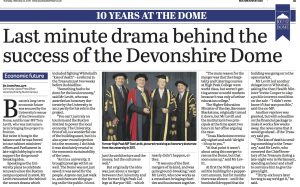As the University of Derby celebrates ten years since it moved in to that wonderful building, the Buxton Dome, Tom reflects with the Buxton Advertiser on his contribution to securing it.
 Buxton’s long term economic future was secured by the University’s rescue of the Devonshire Dome, said former MP Tom Levitt, who was instrumental in bringing the project to fruition.
Buxton’s long term economic future was secured by the University’s rescue of the Devonshire Dome, said former MP Tom Levitt, who was instrumental in bringing the project to fruition.
But twice it hung in the balance and he was forced to tour cabinet ministers’ offices and Parliament in late-night lobbying to win support for the ground-breaking idea.
Speaking as the University plans to celebrate ten years since the Buxton campus opened in 2006 Mr Levitt recounted the behind-the-scenes drama which included fighting Whitehall’s ‘kiss of death’ – a referral to the Treasury just two weeks before the deadline.
‘Something had to be done for the local economy’, said Mr Levitt, who was awarded an honorary doctorate by the University in 2011 partly for his role in the project.
‘You can’t just rely on tourism and the Buxton Festival to power the local economy. The University, first of all, is a wonderful use of the building asset but it is also a year-round injection into the local economy. I do this it was absolutely crucial to the economic sustainability of the town.
‘As it is a University it brings prestige with it as well. The Dome was not just saved, it was saved for the people. Anyone can just walk in and there are things going on for the public. It’s not just the architecture and the money but the culture as well.’
But originally the idea was just about a merger between the University and the former High Peak College at Harpur Hill – which nearly didn’t happen.
‘It was one of the first mergers of its kind and was quite ground-breaking,’ said Mr Levitt, who now works as a consultant bringing charities and businesses together.
‘The main reason for the merger was that the Hospitality and Catering courses at High Peak College were world class but weren’t getting access to world markets because it was only a Further Education college.’
The Higher Education minister of the day, Baroness Blackstone, originally turned the merger down but Mr Levitt and the institutions’ two principals at the time spent two hours in her office arguing the case.
‘Tessa Blackstone eventually sighed and said: ‘All right – it’s up to you’.’
‘At that point it wasn’t about using the merger to save the Dome but that soon came up,’ said Mr Levitt.
At first the NHS agreed to sell the building for a peppercorn amount, but for moths there was silence – until the bombshell dropped that the building was going onto the open market.
Mr Levitt led another delegation to Whitehall, asking the the Health Minister Yvette Cooper to slap a public interest condition on the sale – ‘I didn’t even know if that was possible,’ said the ex-MP.
Another reprieve was granted but with a deadline to make the financial package work only weeks away the news came that it would go ahead – if the Treasury agreed.
‘The kiss of death is ending something to the Treasury,’ said Mr Levitt, who cornered the Chief Secretary to the Treasury during a late-night vote in Parliament, spending an hour and a half to convince him to give the green light.
‘Thirty-six hours later he rang to say we’d got it,’ he said.